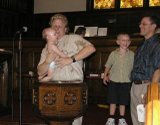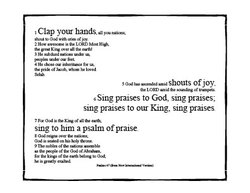There is a lot of interest these days in "Alternative" or "Emerging" worship. There are some interesting books that describe it, and some interesting books that critique it. To see a first-hand account of some "alt" services, check out this annotated photo album.
Continue reading...About
Welcome! This website is intended for thoughtful but harried worship planners. We invite you to explore the resources available here for planning and leading worship.
Since this is a collaborative effort, we also invite you to contribute. All are welcome to comment freely; if you are interested in becoming a posting member of this community, please click here.
If you don't want to post regularly, but do have a question, or want us the community to address a particular issue, feel free to email.
Contributers
Shared Leadership
April 21, 2006
Worship at Austin College —a Presbyterian Church (USA)-related college in Sherman Texas—includes the explicit assumption that all who attend are capable of participating in the leadership of worship. For this reason, after particular students and the College Chaplain plan a given service, a program is prepared that contains every word that anyone will say during the service (with the exception of the Proclamation of the Word and the Words of Institution). Worshipers always sit in a circle around the Communion Table. The portions spoken or sung by the congregation as a whole are printed in bold type. The portions to be read by an individual voice are printed in standard type. The single-voice sections are printed with a line skipped between each sentence or section. Whenever a line is skipped, the next person around the circle reads the next line. In this way, the leadership of the service moves around the circle.
No participant is required to do this. At the beginning of each service, this “Shared Leadership” model is explained and students who do not wish to read are encouraged to inform the persons on either side of them. Then they are simply skipped over as the leadership passes from participant.
This model has proven to be very engaging and liberating for 18-22 year olds who often have little or no experience participating in worship leadership. Over a span of weeks, these services develop a rhythm that is inclusive of all participants, regardless of their particular denominational backgrounds.
Although some students initially express impatience with what they perceive to be the lack of spontaneity in this model, most of them eventually come to appreciate the exposure to the language and rhythms of worship that such a model entails. The fact that the services are planned by students and the Chaplain together helps to ensure that the language employed is authentic and accessible for the whole worshiping community.Continue reading...
Deck the Walls with Praise
April 28, 2006
I've been using a tool for small group worship that has helped bring a fresh twist to 'plain ol' strumming and singing.
I print out twently-four, 8.5 x 11 sheets that each have an artfully fonted, black and white excerpt from the Psalms or some other praise text. If the room is large, I print out double-copies. Before leading, I hang these sheets on the walls of the worship space using scotch tape. Some I hang low on the wall, some eye-level, and some higher. Some sheets, I scatter on the floor. It is best to have the sheets three to five feet apart from each other.
Typically, as I did early this morning for a Fuller D.Min. class, I begin with one song of declaratory praise, sung together. After that song is finished, I play quietly as I explain the worship excercise, saying:Continue reading...
Easter Alleluia
May 09, 2006
 In a class I'm teaching on Crafting Language for Worship, we recently had a discussion about the value of significant words and repeated phrases in worship. Some of my students from evangelical and free-church traditions reported with delight the value they have discovered in the the persistent Easter season call-and-response "Christ is risen! Alleluia!/He is risen indeed, Alleluia!" They report that using this refrain now is profoundly formative, reminding them of the catholicity of the church, and connecting them with the faithful of so many times and places.
In a class I'm teaching on Crafting Language for Worship, we recently had a discussion about the value of significant words and repeated phrases in worship. Some of my students from evangelical and free-church traditions reported with delight the value they have discovered in the the persistent Easter season call-and-response "Christ is risen! Alleluia!/He is risen indeed, Alleluia!" They report that using this refrain now is profoundly formative, reminding them of the catholicity of the church, and connecting them with the faithful of so many times and places.
All of this reminded me of a time when my congregation practiced a fast from the use of the word "Alleluia" throughout the season of Lent in anticipation of its exuberant reintroduction to worship on Easter Sunday. Throughout the forty days, we still sang songs with "alleluia" in the lyrics, but self-consciously hummed "mm-mm-MM-mm" instead.
Meanwhile, the young children of the church spent one of their education hours creating colorful construction paper butterflies, decorated abundantly with the word "Alleluia." These were then crafted into a beautiful mobile, which debuted on Easter morning hanging high over the communion table, pointing to new life in Christ. Alleluia! He is risen!
Continue reading...“Spin the Bottle” Kiss of Peace and Communion
May 23, 2006
While planning a worship service at Austin College in Sherman, Texas, one student said, “If we’re going to do the Kiss of Peace, can we play Spin the Bottle?” Although her comment was intended as a joke, she and the other students—with the encouragement of the college chaplain—developed a version of “Spin the Bottle” as an appropriate and authentic part of our Christian communion service.
After the Invitation to the Lord’s Table, Eucharistic Prayer, and Words of Institution, a worshiper who was chosen before the service began, took an empty water bottle and spun it on the floor of the Chapel. When it came to a stop, the first worshiper and the worshiper toward whom the bottle was pointing met in the middle of the Chapel, exchanged the Mar Thoma Kiss of Peace, and then went to the communion table and served the Eucharist to each other.
Then the next worshiper spun the bottle and met the person toward whom it pointed in the middle of the Chapel. They exchanged the Mar Thoma Kiss of Peace and went to the Table and served the Sacrament to each other.Continue reading...
An Experiment in "Cross-Cultural" Worship
May 23, 2006
Paul’s sermon in Athens (Acts 17:22-31) is substantially different from any of his other sermons. While his other sermons are identifiably Pharisaical and present the gospel in a way that would be accessible to a predominantly Jewish audience, the Athenian sermon employs patterns and concepts which were common to first century Athens. It is a significant and noteworthy accomplishment on Paul’s part and it may be taken as a mandate to subsequent Christians always to be prepared to articulate the gospel message using new and distinct cultural patterns. While the content of the Gospel is always consistent, the form in which the good news of Jesus Christ is presented should always be flexible. What follows are excerpts from a somewhat playful worship service that was designed to illustrate to a worshiping community the issues and possibilities involved in attempting to articulate a Christian worship service in a particular context. College students, youth, and children are often engaged by this way of distinguishing between what is essential and what is negotiable in worship. Read the liturgy after the jump.
***
SCRIPTURE LESSON AND PROCLAMATION—
Luke 10:30-37 and Horton Hears a Who (Theodore Geisel, 1934)Continue reading...
Igniting a Sense of Awe
June 02, 2006
Are we losing our sense of “awe”? I find myself overwhelmed by rocketing gas prices, by the helplessness I feel as I pass a group of homeless men sleeping in the 99 cents store parking lot late at night, and the discontent I feel as I watch my two brothers debilitated by cancer…both with young families. Where is God? Does He care?
 Then I happened upon Don Saliers’ book, Worship Comes to Its Senses (Abingdon Press, Nashville, 1996), which makes me come to my senses, changing my vantage point, to God’s perspective. I realized that my problems were larger than life because I did not think "highly" of God, I had lost my sense of awe. In Matthew 9, some friends bring their paralyzed friend to see Jesus. Jesus said to the man, “Get up, take your mat and go home” (Matt. 9:6). Then in verse 7, the crowd was “filled with awe, and they praised God”. The crowd's view of God was enlarged! They praise God with awe.
Then I happened upon Don Saliers’ book, Worship Comes to Its Senses (Abingdon Press, Nashville, 1996), which makes me come to my senses, changing my vantage point, to God’s perspective. I realized that my problems were larger than life because I did not think "highly" of God, I had lost my sense of awe. In Matthew 9, some friends bring their paralyzed friend to see Jesus. Jesus said to the man, “Get up, take your mat and go home” (Matt. 9:6). Then in verse 7, the crowd was “filled with awe, and they praised God”. The crowd's view of God was enlarged! They praise God with awe.
Saliers encourages us to reconnect real life to the worship of the God of the Universe!
He accents Jaroslav Vajda’s new hymn “God of the Sparrow God of the Whale” which crosses generational lines and is a contemporary way to express to our awe in biblical tradition. Lyrics after the jump...Continue reading...
Living Water
August 10, 2006
 A couple weeks ago I baptized my nephew at his home church in Chicago. Per his parents' request, we used freshly imported water from Lake Michigan. Let's just say that we certainly followed the ancient advice to use "living" water.
A couple weeks ago I baptized my nephew at his home church in Chicago. Per his parents' request, we used freshly imported water from Lake Michigan. Let's just say that we certainly followed the ancient advice to use "living" water.
His parents were eager to do this because their families -- on both sides -- have deep connections to the "Big Lake" as home. In the service, I pointed to the appropriateness of the link the water made between family initiation and initiation into the larger family of God.
But more than that, I suggested that using water from this natural resource -- so dominant and precious to us in the midwest -- highlights the deep connection between the grace of God offered in baptism and the responsibility we gratefully take on as Christ's disciples to care for the world in which that grace is manifest. It says something damning to us if the water in our backyard streams, or rivers, or lakes is so polluted that we cannot in good common sense bathe in it, or in good conscience call it "living" water. Perhaps my nephew Samuel will grow up, in service to Jesus, to be a biologist who concerns himself with the health of Lakes Michigan, Superior, Huron, Ontario, and Erie.

